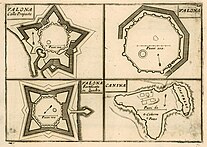
Berat is the ninth most populous city of Albania and the seat of Berat County and Berat Municipality. By air, it is 71 kilometres north of Gjirokastër, 70 kilometres west of Korçë, 70 kilometres south of Tirana, and 33 kilometres east of Fier.

Vlorë is the third most populous city of the Republic of Albania and seat of Vlorë County and Vlorë Municipality. Located in southwestern Albania, Vlorë sprawls on the Bay of Vlorë and is surrounded by the foothills of the Ceraunian Mountains along the Albanian Adriatic and Ionian Sea Coasts. It experiences a Mediterranean climate, which is affected by the Ceraunian Mountains and the proximity to the Mediterranean Sea.

Drobeta-Turnu Severin, colloquially Severin, is a city in Mehedinți County, Oltenia, Romania, on the northern bank of the Danube, close to the Iron Gates. It is one of six Romanian county seats lying on the Danube river. "Drobeta" is the name of the ancient Dacian and Roman towns at the site, and the modern town of Turnu Severin received the additional name of Drobeta during Nicolae Ceaușescu's national-communist dictatorship as part of his myth-making efforts.

Vlorë County is one of the 12 counties of the Republic of Albania with the city of Vlorë being the county capital. The county spans 2,706 square kilometres (1,045 sq mi) and has a total population of 187,675 people as of 2021. It borders the counties of Fier and Gjirokastër, as well as the Adriatic and Ionian Sea. Greece borders Vlorë to the south.

The Regnum Albaniæ was established by Charles of Anjou in the Albanian territories he conquered from the Byzantine Empire in 1271, with the help of the local Albanian nobility. The Kingdom of Albania was declared in late February 1272. The kingdom extended from the region of Durazzo south along the coast to Butrint. A major attempt to advance further in direction of Constantinople failed at the Siege of Berat (1280–1281). A Byzantine counteroffensive soon ensued, which drove the Angevins out of the interior by 1281. The Sicilian Vespers further weakened the position of Charles, and the Kingdom was soon reduced by the Byzantines to a small area around Durazzo. The Angevins held out here, however, until 1368, when the city was captured by Karl Thopia. In 1392, Karl Thopia's son surrendered the city to the Republic of Venice.

Libohovë is a town and a municipality in southern Albania. It is overlooked by Libohovë Castle and has a main street with views across the Drino valley. Libohovë is at the foot of the Bureto Mountain. The region forms part of the Zagori Regional Nature Park located in Zagori region.

Borsh is a maritime village, in the Albanian Riviera, in the former Lukovë municipality, Vlorë County, Albania. At the 2015 local government reform, it became part of the Himarë municipality. The village is inhabited by ethnic Albanians, many of whom have traditionally been Bektashi. In Borsh, the Lab dialect of Albanian is spoken.

Amantia was an ancient city and the main settlement of the Amantes, traditionally located in southern Illyria in classical antiquity. In Hellenistic times the city was either part of Illyria or Epirus. In Roman times it was included within Epirus Nova, in the province of Macedonia. The site has been identified with the village of Ploçë, Vlorë County, Albania. Amantia was designated as an archaeological park on 7 April 2003 by the government of Albania.
Thronion was an Ancient Greek city on the Illyrian coast, in the Bay of Vlorë on the southern Adriatic Sea. Although the earliest contacts appear to have been more pre-colonial activity rather than permanent settlement, an ancient, still archaeologically unproven tradition claims that the city was founded as a Locrian–Euboean colony on the fringes of the territory of the Amantes. Thronion was located to the south of the territory of Apollonia and in front of the Acroceraunian Mountains, the natural boundary between ancient Epirus and Illyria. Thronion was conquered by nearby Apollonia before 460 BCE.

Elbasan Castle is a 15th-century fortress in the city of Elbasan, Albania.
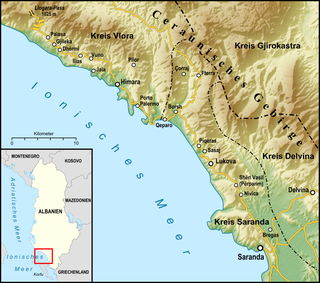
The Albanian Riviera, also popularly known as Bregu, is a coastline along the north-eastern Ionian Sea in the Mediterranean Sea, encompassing the districts of Sarandë and Vlorë in south-western Albania. It forms an important section of the Albanian Ionian Sea Coast, dotted with the villages of Palasë, Dhërmi, Vuno, Himara, Qeparo, Borsh, Piqeras, Lukovë, and the city of Sarandë.
Qendër Vlorë is a former municipality in the Vlorë County, southwestern Albania. At the 2015 local government reform it became a subdivision of the municipality Vlorë. The population at the 2011 census was 7,621. The municipal unit consists of the villages Bestrovë, Babicë e Madhe, Babicë e Vogël, Hoshtimë, Kaninë, Kërkovë, Nartë, Sherishtë, Panaja, Xhyherinë, Zvërnec and Sazan Island. Nartë and Zvërnec are predominantly Greek-speaking settlements.
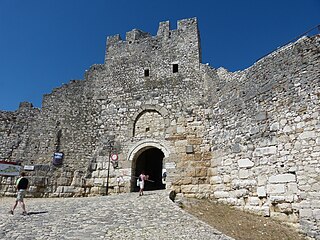
Berat Castle, also referred to as the Citadel of Berat and castle quarter, is a fortress overlooking the town of Berat, Albania. It dates mainly from the 13th century and contains many Byzantine churches in the area and Ottoman mosques. It is built on a rocky hill on the right bank of the river Osum and is accessible only from the south. It is situated at an elevation of 214 metres (702 ft).
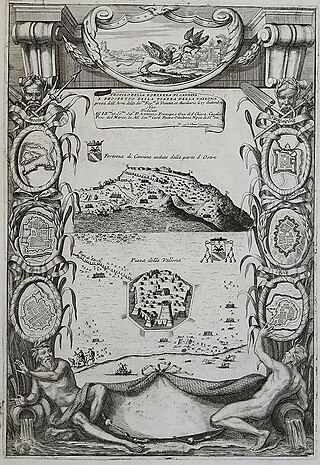
Vlora Castle was a castle in Vlora, Albania. It was built during the reign of Sultan Suleiman the Magnificent and existed until 1906. It was one of the biggest military structures of the Ottoman Empire in the Balkans and had an especially strategic importance for the Ottomans.
Olympe was an ancient city located in the territory of the Amantes, between northern Epirus and southern Illyria in classical antiquity. It is located in modern day Mavrovë, Vlorë County, Albania.

Dukat is a community in Vlorë County, southern Albania. With the 2015 local government reform, it became part of the municipality Vlorë. The Dukat Plain covers an area of around 1,000–1,500 ha delimited by the Ceraunian Mountains and opened in the north towards the Bay of Vlorë on the Adriatic. Dukat traditionally belongs to the Albanian ethnographic region of Labëria.

Dervish Ali's Towers are an early 19th century complex of towers in Dukat, Vlorë County, Albania. It is a Cultural Monument of Albania since 1979
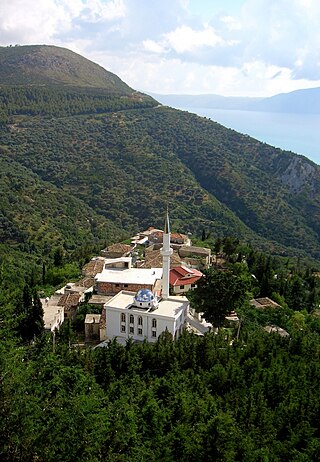
Kaninë is a settlement in the Vlorë County, southwestern Albania. At the 2015 local government reform it became part of the municipality Vlorë. It is home to the Kaninë Castle.
The Battle of Drashovica was a battle of the Albanian Resistance of World War II against Nazi Germany. The battle took place in late 1943, in the areas of Drashovicë and Mavrovë in south-western Albania in the region of Shushicë.

Triport or Treport is a cape and historic harbor on the Adriatic Sea northwest of Vlorë, Albania. It is located in Vlorë municipality, and constitutes the northern limit of the Bay of Vlorë. Located 5 km northwest of the city, the harbor of Triport is the Fishing Port of Vlorë. It is one of the most important fishing ports of Albania, featuring the country's second largest fishing fleet.






